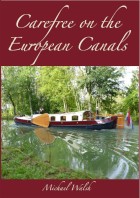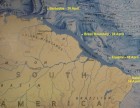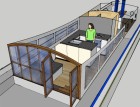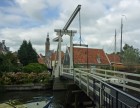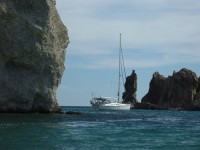Sequitur
Michael & Edi have headed out on a slow, thorough exploration of the globe.
| Vessel Name: | Sequitur and Zonder Zorg |
| Vessel Make/Model: | 2007 Hunter 49 and 1908 Wildschut Skûtsje |
| Hailing Port: | Vancouver, Canada |
| Crew: | Michael Walsh & Edi Gelin |
| About: | For our current location click, on Map & Tracking, then on the Google Earth logo. |
| Extra: | Follow us on Twitter: Follow @YachtSequitur |
| Social: |
13 January 2014
Another New Book Released
I am delighted to announce that my new book: Carefree on the European Canals is now in print and is available on Amazon.com, Amazon.ca [...]
26 April 2013
New Book Released
The proof copy of my new book arrived by courier today. I have approved it and it is now listed on Amazon for pre-order, with a publication date of 30 April. It is a rather large book at 680 pages in an 8.5 by 11 inch format with 315,000 words illustrated by over 2400 colour photos, charts and maps. [...]
24 April 2013
One Year Out of Brazil
One year ago today we sailed Sequitur out of Brazil after enduring more than six weeks in the least-friendly country that we had experienced during our three-year voyage. In the early evening of 24 April 2012 we crossed the line on the chart dividing Brazil from French Guyana and breathed a huge sigh [...]
27 October 2012 | Harlingen, Friesland
Planing a Metamorphosis
We have added a new post to the Zonder Zorg blog at: Planing a Metamorphosis.
29 September 2012 | Sneek, Netherlands
Onward to Friesland
We have arrived in Friesland and have added a new post to the skûtsje's blog at: Onward to Friesland
19 September 2012 | Hoorn, Netherlands
North From Aalsmeer
We have moved northward from Aalsmeer and I have added two new posts: Heading North From Aalsmeer and North From Amsterdam
13 September 2012 | Aalsmeer, Netherlands
Taking Possession
We are back in the Netherlands, and I have added some new posts to the ZonderZorg blog at: Taking Possession and Settling-In and Making Plans
20 August 2012 | Sequitur: St Augustine, USA - Michael & Edi: Vancouver, Canada - Nieuwe Zorg: Aalsmeer, Netherlands
Added a New Website
We have added a new website: Skûtsje ZonderZorg. Zonder zorg in Dutch means without worry. Our intention with the site is to provide a place to share some of the history, geography and culture of the skûtsje as we discover it. We will also use this place to document [...]
11 August 2012 | Sequitur: St Augustine, USA - Michael & Edi: Vancouver, Canada - Nieuwe Zorg: Aalsmeer, Netherlands
Still More Skûtsje History
We continued to attempt to track-down Douwe Albert Visser, who was the owner of Nieuwe Zorg in 1941 when she was re-registered. One of the problems we repeatedly encountered in our online searches was the effect of currently having Albert Visser and two Douwe Vissers as very competitive skûtsje racers, [...]
10 August 2012 | Sequitur: St Augustine, USA - Michael & Edi: Vancouver, Canada - Nieuwe Zorg: Aalsmeer, Netherlands
Some More Skûtsje History
While I was researching the history of Nieuwe Zorg, I finally found her first registration details obscured by an apparent typographical error in a transcribed online spreadsheet. She was listed as having been built in 1901 instead of 1908. I emailed the webmaster of the [...]
Anticipating a Four-Month Trip
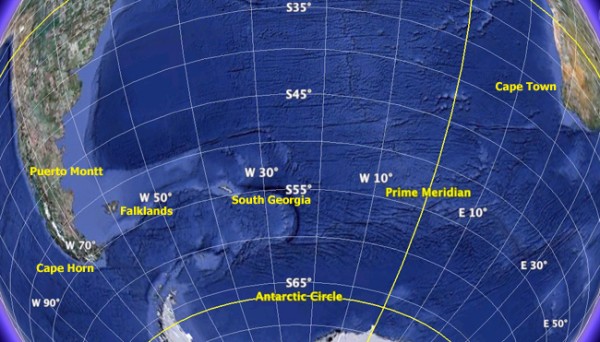
From Puerto Montt, it is over 1200 nautical miles through the Patagonia Channels to Tierra del Fuego and Cape Horn. From there it a little over 400 miles to Stanley in the Falklands, another 800 miles in the Furious Fifties to South Georgia and then over 3000 miles to Cape Town, South Africa. Although the region is spectacularly beautiful, it is a harsh environment that is sparsely-populated and has very few opportunities for supplies and services. Before we leave Puerto Montt, Sequitur must be fully serviceable and tuned, and she needs to be stocked with food, fuel, supplies and spares for four months or longer. While some replenishment is available in Ushuaia, Argentina and Stanley, Falklands, it is rather expensive and it is unwise to depend on finding anything.
We spent Sunday cleaning and re-arranging. This is a much easier task with Sequitur in the water, with electricity from the generator and a hose bib on the float beside the boat. Edi ran four loads of laundry through the washer-dryer and got us caught-up again. I tidied-up the wiring runs from the new black-water pumps and re-stowed our spares in the revamped port after bilge space.

On Monday we took a couple of buses up to Supermercado Lider to continue our stocking-up. For the trip back, we juggled sixty or seventy kilos of groceries and supplies aboard two buses. Heavy items in our bulging wheelie bag, two stuffed cooler bags and two brim-full canvas bags included a dozen bottles of the 2011 Carmen Chardonnay we had 'discovered' in our tasting the previous week, and half a dozen bottles of Undurraga Brut. Among the other heavy items were two dozen cans of shrimp, the first we had seen since California. We love them for omelettes, pizzas, quiches, sandwiches and for so many other dishes, and have searched in vain in every supermarket for two years. It is strange to us that none was available in Mexico, the Galapagos, Peru and until now, Chile.

We also purchased some fresh filete de blanquillo to try. I sautéed it in butter with shredded basil leaves and coarse-ground black pepper and served it with kokoro rice and a butter-sweat of julienned vegetables. The fish is wonderfully firm, nicely flaky and it has a deliciously delicate, non-fishy flavour. It is the least expensive fish in the market, and we assumed that it is unpopular here because it is non-mushy and it doesn't have a heavy fishy flavour. Hooray! We'll buy much more.

On Tuesday morning Edi prepared eggs Sequitur, her take-off on eggs Benedict, with sauce Alfredo, rather than Hollandaise. After breakfast, we continued to clean and organize. While Edi continued sewing covers for our cockpit cushions and pillows, I hauled-out our power-washer and sprayed-down the boat, starting in the cockpit, doing the inside and the out of the canopy, and eventually ending-up at the bow.

When Sequitur had been hauled in June, we had had to cut the wind-generator mast so that she could fit in the travel-lift. The mast had been designed as a fixed unit, welded to the solar arch, and when it was installed by our fit-out yard in Vancouver, it had been wired so short that there was insufficient spare wire to lift the awkward 25-kilogram generator of its mount without cutting the wires at their first emergence from the steel work, down in a cockpit locker. Through David Tideswell, I had contacted Juan Moya, a stainless fabricator to make a 40cm-long clamping sleeve to rejoin the severed mast. He assured us it would be 416 stainless, and would be ready on Monday.

While I was waiting for the stainless fabrication, I spliced an additional metre of wire to the run, and put quick-disconnect fittings on the ends and sealed the connections with heat-shrink. Because I didn't have enough tinned 10AWG, and can find none in Chile, I used twinned lengths of tinned 14AWG to carry the current.

I prepared the ends of the leads from the wind-generator with mating connectors. Once the steel work is complete, the generator will be easy to remove from and to replace on the mast, and the mast will be easy to lower if required again for haul-out.

We had been trickle-charging the battery bank for three weeks, and still could not get the charge up. With the generator now running, I had thought the bank would soon fully charge and hold its charge. It didn't. It looks like a failed bank, and a more local one than the weekly financial crisis in the US these days. I had contacted Gami, the local battery specialist store, and two techs came on Wednesday morning to isolate, load-test and capacity-test the ten batteries in the bank.
When I shut-off the charger and the solar inputs and switched off the main switch for the techs to do the tests, the voltage had been at 14.05 and both battery monitors were showing the bank was 100% charged. The voltage began rapidly falling before the tests were even started. The batteries failed miserably; the worst one showed 22% capacity, the best only 47%. I thought of doing an equalization to try and get a bit more life out of the bank, but with the passages ahead of us, the sound decision is to replace the entire house bank.
I rode back to Gami with the techs, and we looked at options: They had four Trojan T-105 225Ah batteries in stock, and could get an additional six in "a week or so". They also had six Bosch T-105-type 226Ah batteries in stock, and could get the remaining four by Thursday afternoon. Knowing how long "a week or so" is in Latin America, I opted for the Bosch batteries, once I was assured that the price includes delivery and installation. For a million and three-quarters, I had hoped it did.

On Thursday, while we waited for Juan, the steel fabricator and the remote possibility that the battery installers would make it before Friday morning, I went up the mast. I had received notification that there was a recall on the forestay fittings on Selden masts installed between 2004 and 2008 on various models of 12 to 16-metre sailboats: Arcona, Bavaria, Brouwer, Comet Pheonix, Dehler, Elan, Etap, Falcon, Finngulf, Hallberg Rassy, Hunter, Incistor, Maxi, Najad, NIC, Omega, Pronavia, Reflex, Saga, Salona, Southerly, Sweden Yacht and Van de Stadt. I needed to check the part numbers on ours to determine whether they are among the affected ones. As I reached the staysail attachment, I easily saw the part number on the fitting, and noted it was the recalled 517-914. It is so convenient to have the steps installed on the mast, making an excursion like this a simple one-person exercise.

I continued up the mast to the forestay fitting, and confirmed that it also is the questionable one. While I was up the mast, I did a quick visual inspection of the standing rigging, and will do a more thorough one and any necessary tuning when I find a rigger to do the fitting replacements.

From the mast I had a nice view out over the surrounding area. I looked across the floats to the clubhouse and beyond it to the yard to see that over half of the boats had now been put back in the water after their seasonal haul-out or for repairs and maintenance. Like us, many are in the final stages of preparing to leave. Most here are from Europe, and are intending to continue on up the coast a bit before shaping their courses for such places as Isla Pascua, Pitcairn and Polynesia.

Among the non-Europeans in the marina with us at Reloncavi are Max and Sandy of the Australian sloop, Volo, whom we had met in La Punta, Peru last year. They had spent the winter here installing a new engine in their boat. While we were still hauled-out, Edi shot this photo of me in my Jacques Cousteau disguise, chatting with Sandy.

Also among the sailors we had met in La Punta were Steve and Cullam of the ketch, Odyle. Steve's wife Kim had taken a job in the California when they had gone back to escape the southern winter. The job was too good to leave, so she had stayed behind, and Steve and son Cullum left the middle of November to sail Odyle back to California via Pascua, Polynesia and Hawaii.

We had spent the entire day Thursday aboard waiting in vain for the battery techs from Gami and for the steel fabricator. On Friday the 18th I went up to the marina office and had Alexandro call Gami to find out when they were coming. They said there was a shipping delay from Santiago, the batteries were arriving late morning, and they would be at the boat in the afternoon. At 1645 the techs from Gami arrived with new batteries and wheeled them in two cart loads down the floats to Sequitur.

We lugged the ten 28-kilogram batteries aboard, first to the side deck, then to the cockpit and finally down the accommodation ladder to the main salon. The techs carefully mapped-out the wiring diagram of the existing battery bank, so that they could put the complicated set-up back together in the same way with the new batteries.

I figured it made good sense to also shoot photos of the complex wiring scheme before anything was disconnected.

There was one cable with a lightly corroded lug, and I wanted to renew it. I had some 000AWG tinned cable and matching lugs left over from the re-wiring I had done in for the twinning of the engine alternators while we were in Callao last year, so we used some of these spares to make-up a new cable.

I removed the WaterMiser caps from the old batteries and put them onto the new batteries. Shortly after 1930 the installation was completed, and I switched on the 12 volt system, made the breakers for the solar panel input and parallel charge circuit and powered-up the charger. Everything looked good and the bank began taking a charge.

We lugged the old batteries up into the cockpit, then up onto the side deck and finally down onto the float. The techs from Gami were surprised, and I think rather disappointed when I told them they couldn't have the old batteries. It took me a while to communicate this to them in my sparse Spanish and their near total lack of English. I think they were looking forward to equalizing and restoring them and making some money; however, I had the other ideas.

On Saturday as we waited for the new bank to come up to full charge, Edi and I went back into town and walked up the hill to Jumbo for more groceries. Among the items we brought back were half a dozen bottles of our favourite Chilean bubbly: Undurraga Brut Royale, which was on sale. Also on sale was the new 2011 Chardonnay from Cono Sur, at two for 3750 Pesos, or about $3.75 per bottle, so we added four bottles of it to out booty.

As I was beginning to prepare dinner in the early evening, almost exactly 24 hours after the new house battery had been installed, it reached 100% charge. Hopefully, with the new bank, the twinned high-output alternators and the repaired generator, our electrical problems are behind us.

We had finally gone through the first of three ten-kilo bags of basmati rice we had bought wholesale in August 2009 from the importer in Vancouver. So that we could have some with dinner, I opened the second bag.

With the basmati rice, I served filete de blanquillo sautéed with fresh basil, oyster mushrooms, garlic and shallots, accompanied by a butter-sweat of julienned carrots, onions and red and green peppers and garnished with sliced tomato and shredded basil. With dinner we tasted the new 2011 Cono Sur Chardonnay, and found it to be well-structured with nice tropical flavours and a pleasantly long, clean finish. It is a steal at the price; we'll buy much more.

Sunday was cold, windy and rainy. We spent the day onboard doing little things inside, and mostly relaxing. One of the little things Edi did was to freeze some fresh basil leaves. We currently have a wonderful, inexpensive source, and we have already put-up two litres of individual leaves in extra virgin olive oil. The frozen ones will augment and add variety to these.
Monday continued cold, windy and rainy, except instead of just a boring steady rain, we had bouts of heavy downpour added to relieve the monotony. I received a reply from Selden on the mast fittings. Because of the difficulty of our location and the time constraints, Tom Sharkey of Selden USA said: "I will be working with you directly to try to get the issue resolved in the most efficient and logical manner". This is encouraging, since he has commissioned every prototype Hunter has designed since 1998, and is very familiar with our rig.

For breakfast on Tuesday, Edi prepared some pain perdu au jambon from left-over baguettes, and we washed it down with delicious cups of Starbucks coffee. We had finished the last of our Peruvian coffee, and started into the first of many bags of Costco Blend beans (packaged by Starbucks), which we had brought back with us from Vancouver.
After breakfast, I went off to find David and inquire as to whether we had missed the announcement of the retirement party for Juan Moya, the stainless fabricator. We assumed he retired; we haven't seen him since he promised to complete the job in a few days over two weeks previously. David was not around, and one of his workers told me he was not yet back from Santiago, where he had gone on Friday morning.
A severe front came through mid-day, and seemed to stall over us. For much of the remainder of Tuesday a northerly wind howled through Canal Reloncavi and drove a heavy downpour near sideways. We hunkered-down, warm, cozy and dry inside Sequitur. Even if the steel fabricator had shown-up, the weather made it impossible to work on the project.
The storm brought yet another power failure; we've lost count now of how many we've seen here and in Valdivia. David told us of power spikes when the system is re-powered, citing a recent instance in which the power came back on at 440 or 880 volts on Isla Tenglo causing havoc. It is a good idea to disconnect the shore power cord as soon as the power goes out here. With the power outages, the wifi from the clubhouse dies also, and sometimes takes a day or two to restore.

By Wednesday morning the storm had passed, and while the sky was still heavily overcast, it wasn't raining. Late morning, when neither David nor Juan could be found, Edi and I took off on another shopping trip to Jumbo. Our grocery supply for four months is now nearly complete, needing only the final shorter life-span items, which will be purchased the day before we head out. Edi reorganized the stowage yet again; we now have things nicely categorized into fourteen different lockers, and much easier to locate.
On late Wednesday afternoon I received an email from Tom at Selden USA informing me he had just received a shipment of replacement forestay fittings from Sweden, and that a FedEx package was addressed to us and awaiting pick-up in his office. The last international FedEx took two weeks to reach us in Las Hadas, Mexico, so we are hoping that the Chilean system is less broken and corrupt.

On Thursday morning I finally tracked-down David and inquired of the steel fabricator. He told me he needed to contact him urgently, since he had a delinquent part for another boat as well. I also told David the old batteries were on the float, and that he was welcome to take them and see if he could equalize some more life out of them. He said he was rushing off to the LAN office to book a flight to London, his father had just passed away, but that he would contact Juan Moya and see to the batteries. A short while later, one of David's workers arrived with a cart and began hauling away the batteries. However; there was no sign of Juan.
We continued to organize. We have been living aboard for approaching two and a half years now, and things are pretty much stowed in their most logical and convenient locations; however, we continue to tweak. We still have some unused stowage space, for which we will eventually find a use.

On Friday morning Edi arranged a do-it-yourself platter for breakfast consisting of cream cheese, capers, cold-smoked salmon, basil leaves in olive oil and liberally-peppered avocado slices to put onto split baguette chunks from the toaster. This, and the fresh-ground Starbucks coffee provided us with the energy and stimulation we needed for the tedious task of continuing to wait for the steel fabricator and for the FedEx package with the new mast fittings from Selden. Since Thursday afternoon we have been unable to track the FedEx shipment online because of yet another wifi failure.

Saturday dawned clear. It was the first fully sunny morning in well over a week. After breakfast I hauled the spinnaker out of the sail locker and trailed it back into the cockpit so that Edi could repair a tear in it. It had torn near its tack on the point of a sprung spring-clip on the lifelines during our passage to the Galapagos. At the time, I had done a temporary repair with sail tape, which soon flapped free and needed to be reenforced with duct tape. The duct tape held well, but it lacked the required aesthetics.
While we were working on the spinnaker, Alexandro, the Club Manager walked by on the float to check on the workers installing new finger floats on the floating pier. We asked about stainless fabricators, and he knew of none. We asked about the restoration of the wifi, and he told us the telephone company's system had exploded during the recent power outage and restoration. A replacement system is being couriered from the States, and will arrive when it does. We told him our FedEx package with the mast fittings had been shipped on Wednesday, and he said the two-day service sometimes arrives within a week, but it usually takes longer.

While Edi was repairing the spinnaker, I continued preparing Sequitur for sea. I mounted the sail on the Hydrovane wind-steering autopilot, secured the Ankorlina tape reel on the side of the pushpit and adjusted the barbecue on the stern rail. From the sail locker I hauled out the two stuff-bags each with 100 metres of floating line. I checked them over and re-stowed them, ready to secure our bow to rocks or trees ashore in the tight and windy anchorages of Patagonia and Tierra del Fuego.

I also hauled the two stern-line reels out of the port transom locker and mounted them on the stern rails. Each of these also has 100 metres of polypropylene. While the sun continued to shine, we kept at little chores outside, among them, re-connecting the HF antenna, which had been disconnected so we could fit into the travel-lift for haul-out.

As we worked outside, we were able to watch some of the causes of the frequent wakes that sweep through the marina. There is a rather steady marine traffic up and down Canal Reloncavi, the narrow 3.5-mile-long meandering strait that separates Isla Tenglo from the mainland and forms the busy working harbour of Puerto Montt.

Starting around 1730 on Saturday afternoon, a steady stream of heavily laden small boats headed down, their decks crammed with passengers. The most plausible explanation we could conger-up was that these were the people returning from a Saturday excursion to Mercado Angelmo, heading back down the coast to their isolation.

Since we had arrived on the float two weeks previously, we had been admiring the large catamaran moored in the slip across from us. We were initially attracted by the pleasing design and the finely crafted appearance, then we noticed the Alwoplast logo on the side of the house. For two and a half days we had watched as it busily prepared to go out, then late in the afternoon with a dozen-or-so people aboard, it motored away from its slip. Two hours later it came back in.

It still had its main up as it approached the slip. I assumed that the halyard had become stuck, since the skipper attempted to back into his slip with the sail still up. Fortunately there was only a light breeze, four or five knots blowing northward up the channel. Unfortunately it was blowing off the slip and it was a bit fickle, clocking randomly from southeast to southwest. The main was still rather tightly sheeted, rather than being let fly, and on the first approach the breeze veered and blew the cat to starboard.

On the second attempt, the breeze backed around to the southeast, the sail jibed and blew the cat off to port. The skipper made two more attempts while continuing to keep the main sheeted and drawing, and allowing the wind to skew the 55 or 60-foot catamaran off its approach line.

Finally, the skipper realized, or was told, that he still had his mainsail up. There were delegations of people to and from the mast as they tried to figure-out how to lower the sail. Eventually someone must have found the halyard, because the sail started coming down. A couple of conferences later, someone decided what was needed to bring it the rest of the way down. Then with only a few bumps, the cat was safely back in its slip.

It is a good thing we enjoyed the warm sunny Saturday, because Sunday dawned gloomy and drizzly. By mid-morning; however, the drizzle had changed to rain, and this was being slanted by blustery northwest winds as another front came through. We cancelled our planned shopping trip and cocooned inside, practicing for the weather we will encounter as we head toward Tierra del Fuego.

With the high humidity here, we are very pleased with our decision to change our cotton sheets and pillow slips for bamboo ones. Besides their wonderful soft, silky texture, they are totally non-absorptive and have an anti-mildew characteristic. Because they warm very quickly with body heat, they are great to slip between on a cold dank night. We also changed our cotton bath towels for bamboo, and love the way they wick-away water without saturating and then dry quickly.

On Monday morning the sun was back, this time interrupted by a scattering of light cumulus puffs. Not back; however, was the internet connection, so I could not I track the FedEx package with the forestay fitting. After breakfast I went ashore to the office to find some answers. I noted as I passed the catamaran that its mainsail was still in the same heap of disarray in which it had been left after its embarrassing dousing on Saturday.
In the office, Alexandro told me the FedEx package had not arrived. I gave him the tracking number, and he used his iPhone to do a tracking, finding out that it is estimated to arrive on Wednesday. He had no estimate on the restoration of the internet connection. I next went to David's shop to see if there was any news on Juan, the steel fabricator. The steel job had been promised for Monday, and since this was again a Monday, even though the third one now since the promise, we grabbed a sliver of hope that we might see Juan. I saw David as he was scrambling to tie-up loose ends before flying off to London for a couple of weeks. He had spoked with Juan, who had promised to be here later in the day.

While we waited for Juan, we watched the yard crew bring another two fingers for the floats. They have been steadily overhauling and refurbishing the old pieces ashore and floating them into place to re-configure the marina slip lay-out. We anticipate that we will shortly need to move from our berth alongside the long finger; we are in the way of their progress.
As we were watching them delicately maneuver the two floating fingers, a large power cruiser nosed out of its slip and rapidly accelerated, seemingly hoping to create as large a wake as possible as it passed the workers in their tenuous positions. This is yet another demonstration of the widespread lack of wake awareness here, or a blatant disregard for its results.

As we waited for Juan, I hauled-apart the main salon, trying to track-down why the solar panels have ceased to add their charge to the new battery bank. I had been poring through the BlueSky MPPT charge controller's manual for the past few days, searching for wisdom. I had re-done all of the connections on the new batteries, and had scrupulously matched the before-photos of the wiring with the current installation. The troubleshooting pages in the manual had no entry for our combination of readings, and we had no internet connection to follow their advice of looking at their website for other issues. It came as little surprise that another Monday passed without any sign of Juan.

Tuesday dawned relatively clear with a stiff wind from the south driving cumulus past us and into a building stack of dark clouds against the mountains. The yard crew were back at work early, attaching the newly arrived fingers to the float. Just as we finished brunch, there was a knock on the hull; the crew were ready to move Sequitur. The wind was by this time well over 20 knots, so we did the prudent thing and squeezed forward to the last available metre of the float, rather than trying to manoeuvre against the wind onto one of the new fingers.

Once I had re-secured Sequitur in her new position, I went off in search of answers to a list of questions. As I approached the marina office, I saw a telephone company truck in the lot, a bunch of fresh wires on the roof and a new antenna. The office staff confirmed the wifi was about to be restored. All of my other questions could be answered online except: Where is Juan, the stainless steel fabricator?

